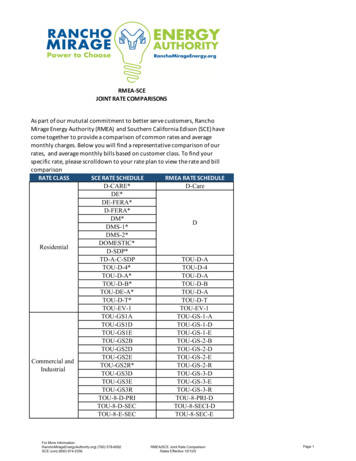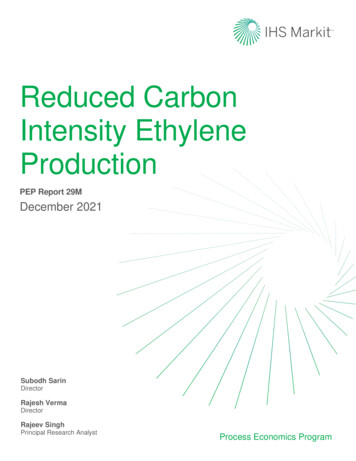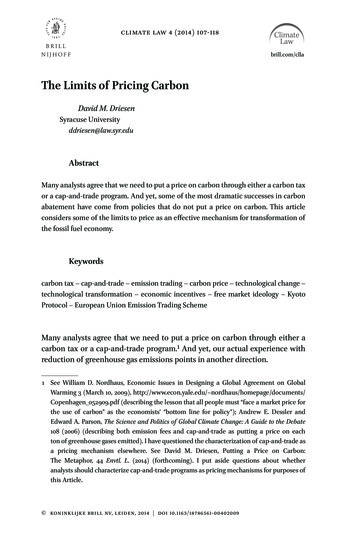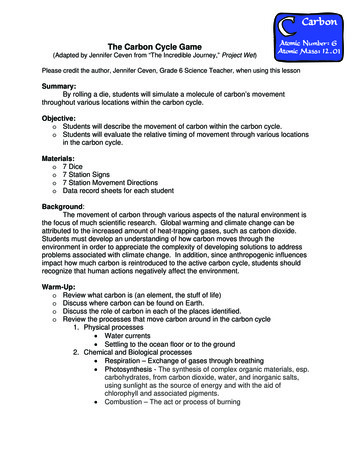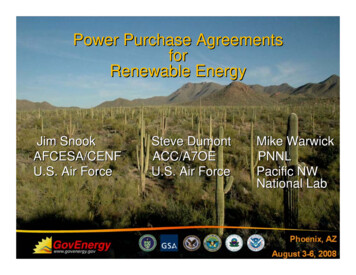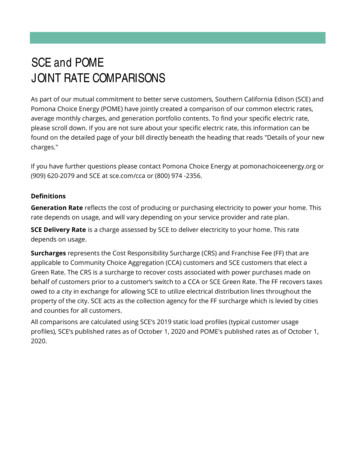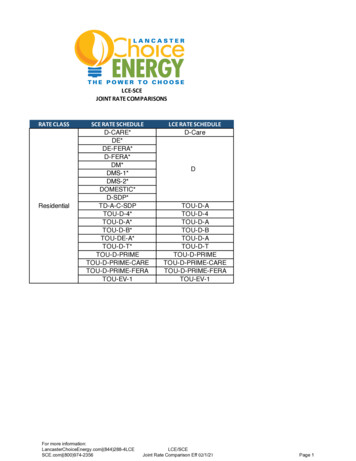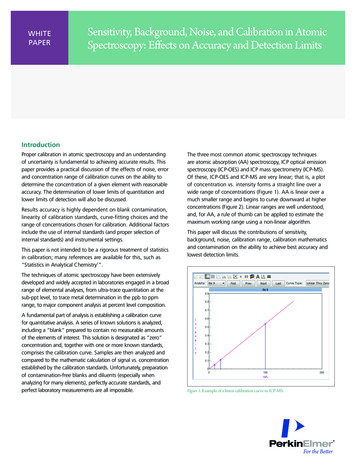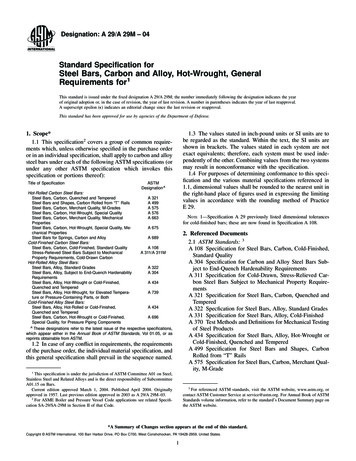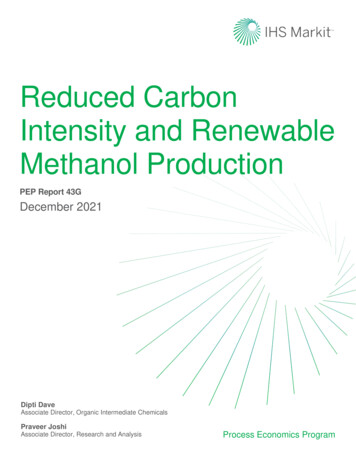
Transcription
Reduced CarbonIntensity and RenewableMethanol ProductionPEP Report 43GDecember 2021Dipti DaveAssociate Director, Organic Intermediate ChemicalsPraveer JoshiAssociate Director, Research and AnalysisProcess Economics Program
IHS Markit PEP Report 43G Reduced Carbon Intensity and Renewable Methanol ProductionContactsDipti DaveAssociate Director, Organic Intermediate Chemicalsdipti.dave@ihsmarkit.comPraveer JoshiAssociate Director, Research and Analysispraveer.joshi@ihsmarkt.comMichael ArnéDirector, Process Economics Programmichael.arne@ihsmarkit.comConfidential. 2021 IHS Markit. All rights reserved.1December 2021
IHS Markit PEP Report 43G Reduced Carbon Intensity and Renewable Methanol ProductionPEP Report 43GReduced Carbon Intensity and Renewable MethanolProductionDipti Dave, Associate Director, Organic Intermediate ChemicalsPraveer Joshi, Associate Director, Research and AnalysisAbstractMethanol is a large-volume commodity chemical that is a major building block for industrial andconsumer products. In 2020, worldwide production was more than 131 MMt. Globally, methanolcapacity has expanded over the past five years at an average rate of 3.5% a year, driven by new plantsbuilt in Northeast Asia, North America, and the Middle East. Mainland China alone accounted for 52%of the global capacity in 2020; it is also the sole producing country in the Northeast Asian region.Our prior PEP Report 43F on conventional methanol production from natural gas was published in2019. It covered four licensed technologies: Haldor Topsøe Autothermal Reforming, Casale andLurgi’s Combined Reforming, and Johnson Matthey/Davy Gas-Heated Reforming-based processes. Inrecent years, there has been significant research on reducing carbon emissions from methanolproduction.The focus of this report is on renewable, low-carbon-intensity, or emission-free, methanol. These areprecommercial technologies. We have examined three processes: Renewable small-scale power to methanol by using German company bse Methanol’s FlexMethanolmodules. Low CO2 emission by natural gas two-stage reforming methanol production, based on the JohnsonMatthey/Davy process, modified with RWGS. Biomass gasification from wood chips and two-stage reforming for methanol production.The iPEP Navigator tool is attached to the electronic version of this report. The iPEP Navigatorinteractive module provides an economic snapshot for each process, allowing the user to select andcompare processes, units, and regions of interest.Confidential. 2021 IHS Markit. All rights reserved.2December 2021
IHS Markit PEP Report 43G Reduced Carbon Intensity and Renewable Methanol gy featuresRenewable energy methanol processLow carbon dioxide emission methanol processBiomass-based methanol processScope 1 carbon analysisTechnical summarybse Methanol’s technologyLow carbon dioxide emission methanol processBiomass-based methanol processSelection of plant capacityProcess economicsIndustry statusProducing companiesDeveloping technologybse Methanol projectsTechnology reviewPEP publicationsIntroductionConventional process technologyConventional versus renewable or low carbonProduct propertiesDeveloping technologiesbse Methanol technologyBackgroundCatalystProprietary equipmentPlot plan including footprintTechnology advantagesLow carbon dioxide emission methanolBiomass-based methanolMethanol production by bse’s FlexMethanol processChemistryFeedstock specificationsReference 120 MW plantProcess description—bse Methanol technologySection 100—Methanol synthesisSection 200—Methanol distillationHydrogen production (G-301)Process discussionPlant modularizationSupporting plant sectionsPlant start-up boilerFeed and utility pricingBy-product steamMaterials of constructionCost estimatesCapital costsConfidential. 2021 IHS Markit. All rights 6December 2021
IHS Markit PEP Report 43G Reduced Carbon Intensity and Renewable Methanol ProductionProduction costsLow carbon dioxide emission methanol production processProcess descriptionSection 100—Syngas productionSection 200—Methanol productionSection 300—RWGS sectionProcess discussionFeedstockUnreacted syngas recyclingMethanol converters sizing estimateConverters feed/product streams configuration and material balanceMethanol product purificationSteam consumptionPlant start-up boilerMaterials of constructionMiscellaneous plant sectionsCost estimatesFixed capital costsProduction costsProcess carbon emission7Biomass-based methanol production processProcess descriptionSection 100—Syngas productionDrying and gasificationDryingGasificationChar destructionGas conditioningSection 200—Methanol productionProcess discussionFeedstockCapacity factorsDrier selectionGasifierCombustorAsh agglomerationGas conditioningScrubbingBiosyngas reforming for methanol synthesisConverters feed/product streams configuration and material balanceMethanol product purificationSteam consumptionPlant start-up boilerMaterials of constructionWaste streamsMiscellaneous plant sectionsCost estimatesFixed capital costsProduction costsProcess carbon emissionAppendix A—Design and cost basisAppendix B—Cited referencesAppendix C—Process flow diagrams6Confidential. 2021 IHS Markit. All rights 8796979797102108111December 2021
IHS Markit PEP Report 43G Reduced Carbon Intensity and Renewable Methanol ProductionTablesTable 2.1 Scope 1 carbon footprint analysis (process streams only)Table 2.2 Process economics of plant configurations for methanol production on the USGCTable 3.1 World top producers of methanol in 2020Table 3.2 Ongoing projects that are in the public domainTable 4.1 Major methanol-derived chemicalsTable 4.2 Methanol purity associated with the main industrial gradesTable 4.3 Specifications for federal AA-grade methanolTable 4.4 Composition of crude methanol produced at the demonstrator plantTable 4.5 Methanol synthesis skidTable 4.6 Distillation skidTable 4.7 Features of FlexMethanolTable 5.1 Feedstock specificationsTable 5.2 Hydrogen propertiesTable 5.3 Carbon dioxide propertiesTable 5.4 bse Methanol process design bases and assumptionsTable 5.5 bse Methanol process stream flowsTable 5.6 Major equipmentTable 5.7 Utilities summaryTable 5.8 Waste effluentsTable 5.9 Total capital investmentTable 5.10 Capital investment by sectionTable 5.11 Production costsTable 5.12 bse Methanol location (Germany)—Production costsTable 6.1 Low CO2 emission methanol production process—Design bases and assumptionsTable 6.2 Low CO2 emission methanol production process—Mainstream flowsTable 6.3 Low CO2 emission methanol production process—Major equipmentTable 6.4 Methanol production by Johnson Matthey/Davy two-stage reforming-based process—Utilities summaryTable 6.5 Low CO2 emission methanol production process—Total fixed capitalTable 6.6 Low CO2 emission methanol production process—Capital investment by sectionTable 6.7 Low CO2 emission methanol production process—Production costsTable 7.1 Biomass-based methanol production—Design bases and assumptionsTable 7.2 Biomass-based methanol production processs—Mainstream flowsTable 7.3 Biomass-based methanol production process—Major equipmentTable 7.4 Biomass-based methanol production process—Utilities summaryTable 7.5 Biomass-based methanol production process—Total fixed capitalTable 7.6 Biomass-based methanol production process—Capital investment by sectionTable 7.7 Biomass-based methanol production process—Production costsConfidential. 2021 IHS Markit. All rights 8495156636972747576828893969899100December 2021
IHS Markit PEP Report 43G Reduced Carbon Intensity and Renewable Methanol ProductionFiguresFigure 2.1 Process scheme of bse’s power to methanolFigure 2.2 Low CO2 emission methanol—Block flow diagramFigure 2.3 FERCO (SilvaGas ) gasifier with methanol production—Block flow diagramFigure 3.1 Companies involved in the research/development/production of bio methanol,renewable (green) methanol, and low-carbon methanolFigure 3.2 World methanol production by raw materialFigure 3.3 World methanol consumptionFigure 3.4 World methanol capacityFigure 4.1 Methanol processFigure 4.2 Process scheme of power to methanol demonstratorFigure 4.3 Photographs of the power-to-methanol demonstrator building, the wind turbine, andthe electrolyzerFigure 4.4 Photograph of the methanol synthesis demonstrator including the reactor, methanolseparator, recycle gas compressor, and the process controlFigure 4.5 Tube bundle methanol synthesis reactor used within the demonstrator plantFigure 4.6 GC-FID1 analyses and composition of crude methanol obtained from the demonstratorplant in recycle modeFigure 4.7 Typical methanol catalyst (Cu/ZnO/Al2O3) in pellet form (0.4mm)Figure 4.8 Example layout for methanol synthesisFigure 4.9 FlexMethanol and the distillation skidsFigure 5.1 Catalytic methanol synthesis from pure gasesFigure 5.3 Methanol product value varies with CO2 feedstock priceFigure 5.4 Methanol product value varies with CO2 feedstock x C FiguresFigure 5.2 (Sheet 1 of 2) bse MethanolFigure 5.2 (Sheet 2 of 2) bse MethanolFigure 6.1 (Sheet 1 of 3) Low CO2 emission methanol production processFigure 6.1 (Sheet 2 of 3) Low CO2 emission methanol production processFigure 6.1 (Sheet 3 of 3) Low CO2 emission methanol production processFigure 7.1 (Sheet 1 of 3) Biomass-based methanol production processFigure 7.1 (Sheet 2 of 3) Biomass-based methanol production processFigure 7.1 (Sheet 3 of 3) Biomass-based methanol production processConfidential. 2021 IHS Markit. All rights reserved.5112113114115116117118119December 2021
DisclaimerThe information contained in this presentation is confidential. Any unauthorized use, disclosure, reproduction, or dissemination, in full or inpart, in any media or by any means, without the prior written permission of IHS Markit or any of its affiliates ("IHS Markit") is strictlyprohibited. IHS Markit owns all IHS Markit logos and trade names contained in this presentation that are subject to license. Opinions,statements, estimates, and projections in this presentation (including other media) are solely those of the individual author(s) at the time ofwriting and do not necessarily reflect the opinions of IHS Markit. Neither IHS Markit nor the author(s) has any obligation to update thispresentation in the event that any content, opinion, statement, estimate, or projection (collectively, "information") changes or subsequentlybecomes inaccurate. IHS Markit makes no warranty, expressed or implied, as to the accuracy, completeness, or timeliness of anyinformation in this presentation, and shall not in any way be liable to any recipient for any inaccuracies or omissions. Without limiting theforegoing, IHS Markit shall have no liability whatsoever to any recipient, whether in contract, in tort (including negligence), under warranty,under statute or otherwise, in respect of any loss or damage suffered by any recipient as a result of or in connection with any informationprovided, or any course of action determined, by it or any third party, whether or not based on any information provided. The inclusion of alink to an external website by IHS Markit should not be understood to be an endorsement of that website or the site's owners (or theirproducts/services). IHS Markit is not responsible for either the content or output of external websites. Copyright 2021, IHS Markit . Allrights reserved and all intellectual property rights are retained by IHS Markit.
Our prior PEP Report 43F on conventional methanol production from natural gas was published in 2019. It covered four licensed technologies: Haldor Topsøe Autothermal Reforming, Casale and

